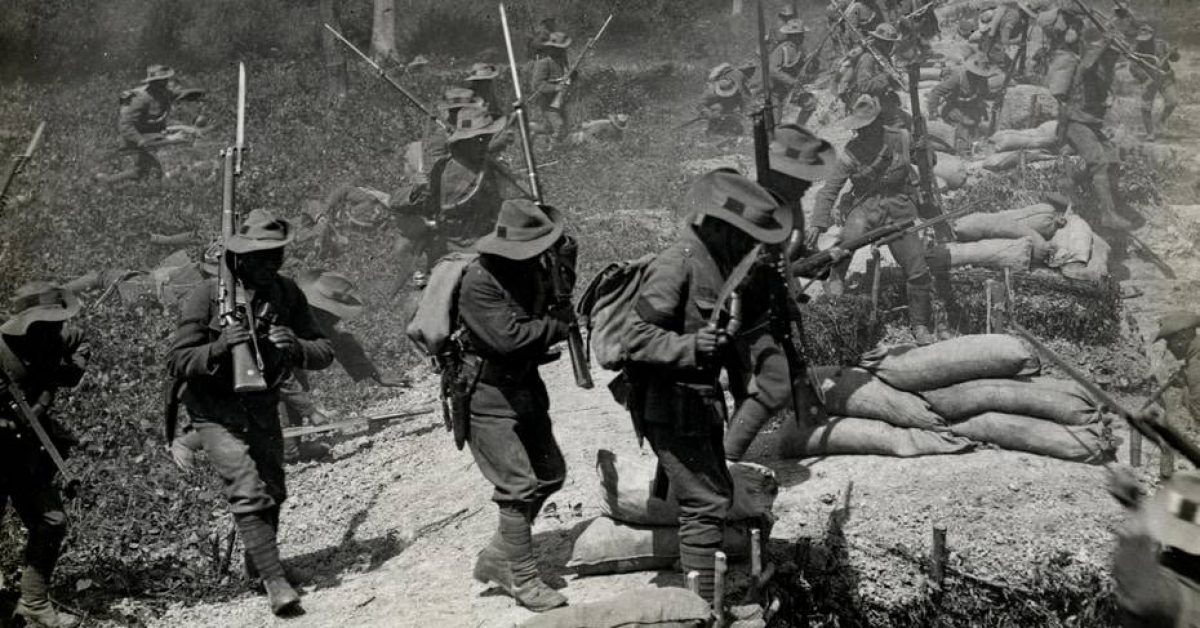The Age of World Wars (1914-1945)

The First World War
The warring parties of World War I.
The alliance system that triggered the war was the Central Powers: Germany, Austro-Hungarian Monarchy, Turkish Empire, Bulgaria. It is based on the Triple Alliance of 1882: the Alliance of Germany, the Monarchy and Italy for defense (not offense) against
Russia and France.
- The war was initiated by Germany and the Monarchy, with no reference to Italy initially joining.
- The Turkish Empire joined in 1914 because of its opposition to Russia.
- Bulgaria wanted to retaliate on Serbia, but only joined & mobilized in 1915 in the hope of a sure victory.
The other array was the Entente Powers: France, Russia, Britain, Belgium, Japan, Italy, Serbia, Romania, Greece, USA.
- It is based on the Triple Entente of 1907: Treaty between France, Russia and Great Britain (Franco-Russian alliance+cordial agreement+Russo-British agreement). It obliged only France and Russia to defend each other against Germany and the Monarchy. Britain, however, was merely connected to the other two powers by friendly treaties and treaties separating colonial interests. Belgium was invaded by Germany for strategic reasons, thus Britain declared war(Treaty of London made it bound to defend Belgium).
- Japan wanted to seize German interests in the Far East (to expand its sphere of influence in China and the Pacific), therefore, it joined in 1914, but did not intervene in the European struggle.
- In 1915, Italy turned against its former allies: it sought the Italian-inhabited territories of the Monarchy and Balkan influence.
- Romania joined in 1916 in hopes of acquiring Transylvania, and Greece in 1917 against Bulgaria (Bulgaria wanted revenge) and Turkey (for land).
- The most significant was the accession of the USA in 1917: after the secession of Russia, this greatly decided the war.
Fronts
The First World War took place between 1914-18 between the Central Powers and the Entente Powers, mostly in Europe but also in the colonial territories. The excuse for its detonation was the assassination of Franz Ferdinand, the heir to the Austro-Hungarian throne in Sarajevo in 1914 June 28. A month later, on July 28, 1914, the Monarchy declared war on Serbia.
The clashes that used the most forces and decided the war took place on the Western Front:
- In 1914, German troops stormed Belgium, invaded France, but were stopped by French-British forces at the Marne. Germany’s goal would have been to avoid a two-front war, by defeating France quickly(swiftly). However, the idea of a quick victory failed, attrition warfare (& trench warfare) ensued instead.
- In 1916, German forces launched an offensive at Verdun and the British at the Somme, but despite the huge losses, the front line did not change significantly-stalemate.
- In the Spring Offensive of 1918, the Germans attacked again (troop reinforcements came from the withdrawn Eastern Front), but were repulsed by the Entente forces reinforced with the Americans.
- In the summer, the Entente troops attacked, broke through the front, and ended the war (Armistice at Compiegne November 11, 1918).
The Eastern Front was the longest (in size), so typically there was no stalemate (thus no trench warfare):
- In 1914, Russian forces invaded Germany (East Prussia) and the Monarchy (Galicia), but were stopped in both places.2. In 1915, German and Austro-Hungarian forces broke through the Russian front and occupied Tsarist Poland & the territory of the Baltic States.
- In 1916, the Russians attacked again, and with the entry of Romania, the Entente troops also invaded Transylvania. They were repulsed by the redeployment of German forces (however, with this, the Monarchy was completely subordinated to Germany).
- In 1917, the Russian Revolution broke out. The last Russian attack collapsed, the Germans invaded vast territories, with this the First World War ended here (in the East).
The history of the Balkan Front was actually two separate series of events:
- The Monarchy invaded Serbia as early as 1914, but the attack was halted by the Galician invasion of the Russians.
- With the accession of Bulgaria in 1915, Serbia was then defeated (it surrendered).
- In 1918, the French-British-Italian-Serbian-Greek forces defeated the Turks, the Bulgarians, and then the Austro-Hungarian forces (Armistice: November 3, 1918, Padua).
The Italian front or Alpine front was formed with the entry of Italy on the Italian-Austrian border in 1915 (Isonzo, Doberdo) and was predominantly a stalemate.
- In 1917, Austro-Hungarian forces broke through the front and pushed to Piave, from where they were counter attacked in 1918 by Italian-British-French-American troops.
Compared to the above, there was little fighting between the forces on the other fronts
- The Turkish Empire fought Russian forces in the Caucasus and British forces on the border with Egypt and southern Iraq. It suffered a defeat.
- In 1915, the British tried to occupy Gallipoli but failed. (The Armenian genocide took place during the war.)
- The German colonies surrendered in a row, cut off from the mainland.
- The English fleet blockaded Germany. Both the 1914 Heligoland Bight and 1916 Jutland sortie attempts were German failures(both Britain and Germany claimed victory in the Battle of Jutland).
- Germany declared unrestricted submarine warfare in 1917, which provoked U.S. entry.
The nature and characteristics of the War
- Germany, which declared the war, was prepared for a quick victory: After the rapid invasion of France, it also wanted to force Russia to peace.
- However, Britain’s intervention leveled the balance of power (the conflict became futile), a war of attrition ensued, which was then decided by US entry.
- The trench warfare meant that the two opposing armies dug themselves into trenches, settling in for defense (long-term protection, sleeping, eating).
- Breaking through the standstill front lines was only possible with a huge force(e.g. tank) and in any case caused unprecedented losses.
- The modern weapons used in the war (tank, plane, chemical weapon) have not yet proved decisive.
- As the war dragged on, the strength of the economy and the resilience (effort) of the homefront (‘hinterland’) became more important – it was a total war:
- The state intervened everywhere in the production(war economy, planned economy) and in the distribution of consumer goods (rationing).
- Governments became indebted and inflation arose.
- Partly due to the Blockade of Germany/the Blockade of Europe(British blockade, conducted by the Triple-Entente powers to restrict the maritime supply of goods to the Central Powers), the resources of the central powers were soon exhausted.
- U.S. loans helped the Entente, but also made the U.S. interested in the Entente’s victory.
- The war used the population and financial resources of the belligerent countries to a greater extent than ever before. This was possible because with the formation of nation-states, the majority of the population identified with the goals of the state, i.e., they considered the events as a war of nations rather than states.
Great power interests in peace talks
The goal of the peace treaty that ended World War I, in addition to imposing penalties on those who were a reason for the starting of the war, was a just settlement that would ensure peace in the long run. In reality, however, the interests of power prevailed.
- France’s goal was
- to weaken Germany‘s military and economy.
- also to create a French sphere of influence in Central Europe that would also isolate weakened Germany and weakened Russia, keeping Bolshevism away from Europe.
- Britain wanted to:
- maintain a continental balance of power, that is, it did not want France to become too strong at the expense of Germany. But even more important was the expansion of its colonial empire (colonial policy).
- Italy wanted Italian-inhabited territories and Balkan influence.
- The latter was denied by its allies because Italy’s military performance was unconvincing and the area was already promised to French-friendly small states.
- Russia became isolated as a result of the revolution and the civil war, even in early 1918 it made a separate peace treaty with Germany and did not take part in the peace talks/conference.
- Japan acquired the German colonies in the Far East, proving uninterested in other matters.
- U.S. President, Wilson, sought a complete reorganization of power relations
- Fourteen Points would have ensured a just peace with the losers and American trade influence.
- He proposed general decommissioning – disarm to the lowest point consistent with domestic safety.
- He would have abolished secret diplomacy and refused to recognize private understandings made before and during the war.
- Absolute full freedom of navigation and trade upon the seas.
- Adjustment of all colonial claims based upon observance of the interests of the colonial populations(self-determination).
- He would have restored the sovereignty of the occupied countries, re-established Poland, returned Alsace-Lorraine to France, and given South Tyrol and Trieste to Italy.
- He promised the people of the Austro-Hungarian Monarchy and the Ottoman Empire „freest opportunity to autonomous development”, which the leaders of the national minorities interpreted as independence, while the Hungarian and Turkish leadership interpreted it as autonomy only.
- He would have created the League of Nations to ensure peace.
- As his allies rejected the plans, the U.S. withdrew from the peace talks. (He later made a separate peace with the losing states.)
The defeated countries were not invited to peace talks, only at the end they were told the discussed facts.
Germany was held responsible for starting the war, so harsh penalties were imposed. German public opinion felt this was unfair, confirmed by the fact that Germany won on the Eastern Front and that the West also suffered defeat, only after the US entered did they gain the upper hand.
The Austro-Hungarian Monarchy practically fell apart by the time of the peace talks. According to the victors, its historic role in the balance of power in Europe came to an end, as it was
subjugated to Germany in the war and was no longer needed to offset weakened Russia.
The great powers often referred to the principle of self determination of nations and included in the peace treaties the needs of their small allies, Serbia and Romania, as well as the ideas of Czech and Croatian emigration.
Common elements of peace treaties
The Peace Conference met in Paris in 1919, chaired by French Prime Minister Clemenceau. Once the victorious powers agreed, the defeated were only invited to sign in the castles around Paris.
The reason for the redrawing of borders was, in principle, the right of peoples to self-determination: the Entente promised the creation of nation-states. In reality, borders were also influenced by economic and military considerations, always in favor of the victorious powers and the states created by the victors.
The defeated were ordered to pay compensation. The amount of this was not dictated, but was decided at international conferences in the 1920s, so the settlement of the issue dragged on until 1932, further poisoning the relationship between winners and losers.
In the defeated states, conscription was abolished and the size and armament of the army was limited.
The defeated lost their colonies (practically only Germany had).
The League of Nations was formed at Wilson’s suggestion.
- Its members were the victors, although the US was no longer involved. The losing states were only later admitted.
- The goal of the organization was to preserve world peace, which it could not achieve, as it never had all the major powers at once.
- Minority protection issues could also be addressed to the League of Nations: the rights of minorities who moved to other countries due to border changes were guaranteed by the peace treaties, and the League of Nations was rendered arbitrator.
- Its main bodies were the General Assembly, which represents all the member states, the Executive Council, which operates with the permanent membership of major powers, and the Court of International Justice – often called the World Court – in The Hague.
Lapozz a további részletekért



